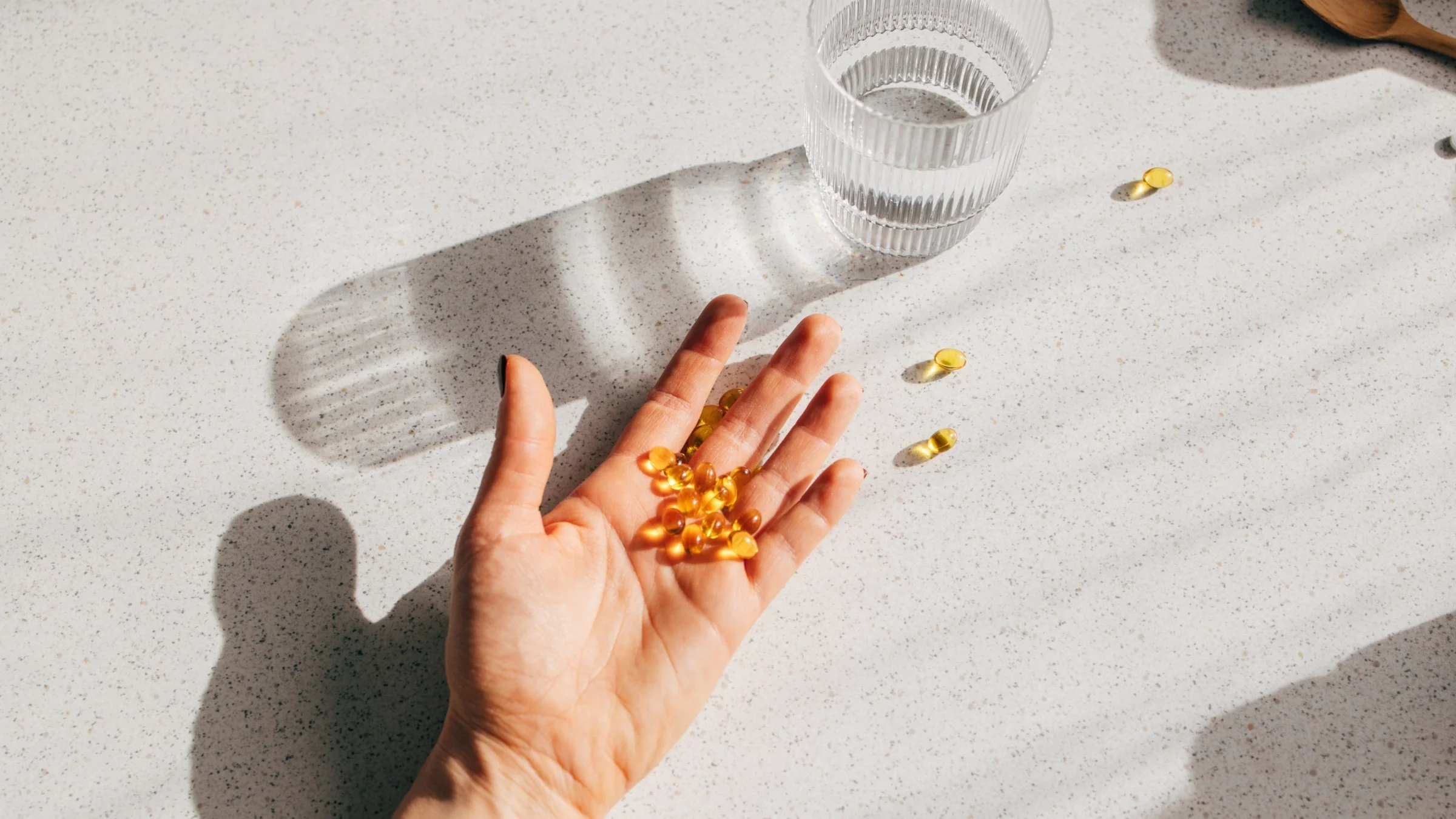Key takeaways:
The recommended daily amount of vitamin D for adults is 600 international units (IU) a day. Adults over the age of 70 need a little more — 800 IU.
If you are at higher risk for vitamin D deficiency, it’s important to have your levels tested. If they are low, you may need to take more vitamin D.
If you take too much vitamin D every day, it can lead to health problems. Your body cannot easily get rid of excess vitamin D.
Save on related medications
Almost half of all people in the U.S. aren’t getting enough vitamin D. Vitamin D is important for everything from bone health to mood. For a long time, we have known how vitamin D deficiency can lead to osteoporosis in adults and rickets in children. But researchers are learning how low vitamin D can lead to other health problems — like heart disease, immune system dysfunction, depression, and cancer.
But how do you tell if you have enough vitamin D? And how much is too much vitamin D? Here’s what you need to know.
How much vitamin D per day should I be taking daily?
Experts have actually debated this question. The specific amount of vitamin D you need varies by age — and whether your levels are low. For people who have normal vitamin D levels, the recommended daily allowances are listed below in both micrograms (mcg) and international units (IU).
Search and compare options
Age | Recommended daily allowance of vitamin D |
|---|---|
Birth-12 months | 10 mcg (400 IU) |
1-13 years | 15 mcg (600 IU) |
14-18 years | 15 mcg (600 IU) |
19-70 years | 15 mcg (600 IU) |
71 years and older | 20 mcg (800 IU) |
According to most medical experts, the recommended dietary allowance (RDA) of vitamin D for adults up to age 70 is 600 IU. But some professional organizations recommend 20 mcg per day, or 800 IU.
How much vitamin D per day for a woman?
Women need the same amount of vitamin D per day as men.
Researchers have looked into sex differences in vitamin D levels. Some studies show low vitamin D is more common in women. Others show it’s more common in men. It’s also possible that women are more likely than men to experience health complications from low vitamin D levels — especially when it comes to bone and muscle health.
All that being said, this doesn’t change the recommended amounts of vitamin D. The RDA for women younger than 70 years is 600 IU. This includes anyone who is pregnant or lactating.
Which vitamin D supplement should I take?
If you’re thinking about taking a vitamin D supplement, they are available as vitamin D2 or vitamin D3. Both types of vitamin D will increase your levels.
The difference between vitamin D2 and D3 is that D2 comes from plants, and D3 comes from animals. Studies suggest that vitamin D3 increases vitamin D levels faster than vitamin D2 does, especially at higher doses.
Vitamin D dosage guide: Learn all about the different types of vitamin D, over-the-counter and prescription options, dosage, and the safest way to take them.
Does vitamin D give you energy? If low vitamin D is affecting your mood and energy levels, taking a supplement may help give you a boost.
Vitamin D medication interactions: Vitamin D can interact with a number of common medications. Check the list before you start a supplement.
How much vitamin D3 should I take per day?
Vitamin D3 is available in the following doses:
400 IU
800 IU
1,000 IU
2,000 IU
5,000 IU
10,000 IU
50,000 IU (available by prescription only)
If your vitamin D levels are really low, you may need one of the higher high doses. But this should be done under the guidance of a healthcare professional. People with vitamin D levels less than 20 ng/mL often start with doses of 50,000 IU of vitamin D3, once a week for 6 to 8 weeks. After that, a dose of 800 IU to 2,000 IU per day can help maintain vitamin D levels above 30 ng/mL.
Read more like this
Explore these related articles, suggested for readers like you.
After taking vitamin D supplements for 3 to 4 months, have your levels rechecked to ensure you’re on the right track.
What happens if I take too much vitamin D?
If you take too much vitamin D, this can lead to high levels of calcium in the blood. This is because vitamin D increases calcium absorption in the gut. Too much calcium in the blood — a condition called hypercalcemia — can lead to:
Nausea and vomiting
Muscle weakness
Kidney stones
Confusion
Dehydration
The risk of hypercalcemia increases if you’re also taking calcium supplements alongside vitamin D supplements.
Very high levels of vitamin D can cause kidney failure, irregular heart rhythms, and even death. But taking enough vitamin D to cause these problems is rare, and is usually due to excessive intake of high-dose supplements. You are unlikely to take too much vitamin D if you stick to the recommended doses of vitamin D supplements.
What is the best way to get more vitamin D?
With so much talk around supplements, it’s easy to forget that there are natural ways to get vitamin D.
Sunlight
Sunlight is one of the main sources for your daily vitamin D. That’s because your skin makes vitamin D when it absorbs ultraviolet (UV) light. For people with a lighter skin tone, fewer than 20 minutes of sun exposure may be enough to make their daily dose of vitamin D. People with a darker skin tone need a little more time, about 25 minutes. But remember that too much sun exposure increases your risk of skin cancer. This is why food is an important source of vitamin D too.
Foods high in vitamin D
There are not a lot of food sources that naturally contain vitamin D. This is why it’s added to common foods like milk and breakfast cereals.
Foods that are high in vitamin D include:
Cod liver oil
Trout
Salmon
Tuna
Red meat
Egg yolk
Fortified breakfast cereals
Fortified dairy products
Mushrooms
Chicken breast
Sardines
How do you know if you’re vitamin D deficient?
Most adults don’t need to be tested unless they are at high risk for having low vitamin D.
If you’re at risk, a simple blood test with your primary care provider will tell you if you’re vitamin D deficient. The test measures your “25-hydroxyvitamin D” levels.
A normal vitamin D level is between 30 ng/mL and 100 ng/mL. Most experts agree that a vitamin D level less than 20 ng/mL is considered deficient. And severe deficiency is defined as a vitamin D level of less than 12 ng/mL.
Vitamin D deficiency risk factors
You might be at risk for vitamin D deficiency if you:
Live in an area with low sunlight
Have darker skin tone
Are older (the ability to make vitamin D decreases with age)
Spend little time outside, or rarely expose your skin to sunlight
Have increased body weight
Take medications that affect how quickly you process vitamin D (such as phenytoin or orlistat)
Have a condition that impairs vitamin D absorption from your gut (like inflammatory bowel disease, celiac disease, or prior gastric bypass surgery)
If you think you may be at risk for low vitamin D, reach out to your primary care provider. Together you can decide if you should be tested.
Frequently asked questions
The best time to take vitamin D is when you’re eating a meal that contains fat. Vitamin D is a fat-soluble vitamin, so fat helps your body absorb it. But it doesn’t matter if you take it in the morning or night.
No. Since vitamin D is a fat-soluble vitamin D, excess amounts get stored in the body rather than excreted through urine. This is why it’s important not to take more than the daily recommended amount.
Vitamin D supplements can interact with some medications. These include:
Some statins, such as atorvastatin (Lipitor) and simvastatin (Zocor)
Bile acid sequestrants, such as cholestyramine
Some antibiotics, such as rifampin and isoniazid
Some seizure medications, such as phenytoin and carbamazepine
Orlistat
Digoxin
Hydrochlorothiazide, a diuretic
The best time to take vitamin D is when you’re eating a meal that contains fat. Vitamin D is a fat-soluble vitamin, so fat helps your body absorb it. But it doesn’t matter if you take it in the morning or night.
No. Since vitamin D is a fat-soluble vitamin D, excess amounts get stored in the body rather than excreted through urine. This is why it’s important not to take more than the daily recommended amount.
Vitamin D supplements can interact with some medications. These include:
Some statins, such as atorvastatin (Lipitor) and simvastatin (Zocor)
Bile acid sequestrants, such as cholestyramine
Some antibiotics, such as rifampin and isoniazid
Some seizure medications, such as phenytoin and carbamazepine
Orlistat
Digoxin
Hydrochlorothiazide, a diuretic
The bottom line
Vitamin D is an important nutrient that helps with bone health, mood, and immune strength. The easiest way to get vitamin D is through sunlight and diet. But this may not be enough for everyone. If you think you’re deficient in vitamin D, you can take a blood test to find out. If your vitamin D levels are low, you may need supplements. But the right dose depends on your age and your level of deficiency.

Why trust our experts?


References
Amrein, K., et al. (2020). Vitamin D deficiency 2.0: An update on the current status worldwide. European Journal of Clinical Nutrition.
Cui, A., et al. (2022). Prevalence, trend, and predictor analyses of vitamin D deficiency in the US population, 2001–2018. Frontiers in Nutrition.
Molfetta, I. V. D., et al. (2024). Vitamin D and its role on the fatigue mitigation: A narrative review. Nutrients.
Office of Dietary Supplements. (2022). Vitamin D: Fact sheet for consumers. National Institutes of Health.
Office of Dietary Supplements. (2025). Vitamin D: Fact sheet for health professionals. National Institutes of Health.
U.S. Preventive Services Task Force. (2015). Screening for vitamin D deficiency in adults: U.S. preventive services task force recommendation statement. Annals of Internal Medicine.
Webb, A. R., et al. (2018). Colour counts: Sunlight and skin type as drivers of vitamin D deficiency at UK latitudes. Nutrients.
Wierzbicka, A., et al. (2022). Sex differences in vitamin D metabolism, serum levels and action. British Journal of Nutrition.

















